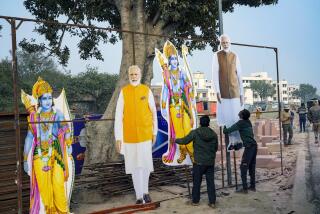Lulled into a fog-induced limbo aboard an Indian train

ABOARD THE PRAYAGRAJ EXPRESS, India — We’re late. Very late. A nine-hour overnight train trip has turned into 16, and we’re still miles from nowhere. It’s winter in northern India and that means fog, great gobs of the stuff wreathing the land, causing shapes to appear out of the mist before slinking back into the void.
Trains slow to a crawl. Airports come to a standstill. You’re thinking: Cue the apoplectic passengers, minds racing to reconfigure digital calendars, a flurry of calls, texts, the jitter of tapping feet.
But life in India maintains its timeless grace, at least here aboard the Prayagraj Express, making its way from central Uttar Pradesh state to New Delhi.
“This is part of life; you get used to it,” says Pradeep Dubey, a low-level bureaucrat returning from a conference, one of eight passengers in car B3, a third-class AC sleeper compartment of beds stacked two or three high.
Delays aren’t all bad. With our scheduled 6:45 a.m. arrival in New Delhi out of the question, passengers enjoy a good sleep-in punctuated by a disjointed symphony of snores. The tinny speakers are blessedly quiet, happy not to state the obvious: It’s winter. There’s fog. We’re late.
“I slept twice. It was great,” says Parth Ranjan Ghosh, a government official traveling with Dubey. “Great dreams.”
Nor is there any early-morning line for the squat toilets at the end of the car, their foul smell tempered by air blowing up from the hole that reveals the well-worn tracks below.
“Please do not use the toilets when the train stops at the station,” a red-and-white sign warns above a commode displaying little evidence of a design change since they were introduced on Indian trains in 1891. (For the moneyed classes, that is. The masses would wait 16 more years to do their business in a loo on the move.)
Late trains also provide an excuse to play hooky. Dubey was supposed to meet colleagues at noon, but will miss that appointment and, with each passing minute, is closer to writing off the day of slogging in a bureaucracy of slow-moving fans and slower-moving files.
“I think I’ll skip out altogether,” he says. “Too many boring meetings.”
As the carriage comes to life, the compartment undergoes a transformation as top bunks groan under the weight of heavy blankets and rumpled sheets, the middle tier folds into a seat back and the bottom tier becomes a bench, with passengers, luggage and shoes rearranged accordingly.
Since this was supposed to be a relatively short trip, there’s no food car. That creates one near-desperate emotion among passengers of all castes, creeds and travel classes as they struggle for consciousness, and that first cup of the sweet milky tea that powers the nation and the diabetes count: WHERE’S MY CHAI?
Around 9:30, there’s a brief stop at a small station called Tundla, little more than a platform surrounded by fields. Within seconds many of the train’s riders tumble onto the normally quiet platform, mobbing chai-wallahs who haven’t sold so much tea since, well, since the last delayed train a few hours ago.
Back in the carriage to the scream of a horn, and day-old newspapers are passed around until they resemble crinoline. Never keen to miss an opportunity, a slew of dodgy hawkers boards at the next station offering watery instant coffee at a significant markup.
As the hours pass, snacks are shared and barriers fall, never difficult in this vibrant nation of talkers. Issues are raised, wrung out and dropped: what to do about Pakistan, a timeless topic; what of all the corruption in our midst, equally timeless.
Someone mentions a friend who certifies industrial goods at factories who has opted not to take bribes for letting defects slide by. Admiration all around. Who among us is corrupt? a passenger asks. You never know from looking at people, he adds, to nods all around. A rough consensus emerges: Only our children save us from being crooked, the thought of what you’d tell them if you’re caught one day. More nodding.
Talk turns to the Indian train system, a creation of the British imperialists who ruled for two centuries before being told good riddance to bad rubbish but who, most agree, got this one right. These may not be the sleekest, cleanest carriages in the world. But a network that’s been called India’s circulatory system, binding a vast and diverse nation, has earned its riders’ love and respect.
Vijay Kumar Tiwari, a railway employee traveling for pleasure, waxes eloquent on delays, explaining how backlogs after a thick fog can last hours, even days, as supervisors re-choreograph some 11,000 trains crisscrossing India each day.
Among the fog fixes tried over the years were yellow paint, louder whistles, GPS systems and “detonators,” an 1841 invention still in widespread use that simulates an explosion when trains approach signals. None has proved particularly effective. A few months ago, in a rail milestone of sorts, fog got its own website, allowing viewers to watch little trains on green tracks crawling behind schedule across the screen.
This year is the 160th anniversary of India’s first train, which ran the 20-some miles from Bombay (now Mumbai) to Thane. This route between New Delhi and Allahabad, nearly 400 miles through much of densely populated Uttar Pradesh, is among the best, Tiwari says, given the number of VIPs traveling to Allahabad’s high court.
“It’s safety first, schedule second,” adds Tiwari, a lover of 1960s Bollywood crooners he has played aloud on his not-so-smart phone through much of the night. “The music calms me,” he says.
This inspires a discussion of dream train trips, with one passenger offering up the Orient Express, another an extravagance aboard the trans-Siberian railroad, a third the train beneath the English Channel.
As the midday sun burns off some of the fog, a momentary silence settles over the cabin, faces taking in green fields of rice marked by dirt dividers and the toil of oxen behind wooden plows. As the miles pass, buildings get bigger and fields get smaller until they disappear completely, replaced by growing patches of plastic garbage as New Delhi nears.
A few miles from the capital, Dubey gets off. “I’ve been on this thing so long, I imagine I’ll still feel like I’m on a swaying train several hours from now,” he says with a wave before heading off down the platform.
Finally, at 2:14 p.m., nearly eight hours behind schedule, the Prayagraj Express lumbers its last hundred feet into the New Delhi terminal amid a tangle of sharp elbows, oversized bags and jostling red-coated porters. There are a few handshakes and smiles among the temporary residents of car B3 before they scatter into the anonymity of the city.
Tanvi Sharma of The Times’ New Delhi bureau contributed to this report.
More to Read
Start your day right
Sign up for Essential California for news, features and recommendations from the L.A. Times and beyond in your inbox six days a week.
You may occasionally receive promotional content from the Los Angeles Times.






